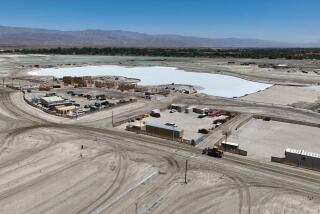Unforgotten : Corriganville: A Hollywood stuntman’s crusade to restore a Wild West park to its former glory is running out of money.
Hollywood stuntman Steve Gillum set out in 1988 to restore Corriganville, the Simi Valley movie ranch and Wild West amusement park that first hooked him on show business.
He visited the ranch so often as a youngster, Gillum says, that owner Ray (Crash) Corrigan finally put him to work there as a gunfighter in the mock battles staged for visitors.
“In those days you could do anywhere from 10 to 20 different shows a day,” he recalled. “It consisted of falling off roofs, falling off a rock, falling off a horse. Anything you used to see in a Western film they would try to duplicate for the public.”
“I wanted (Corriganville) back because of what it meant to me.”
The ranch was closed to the public in 1967. Its last Western sets went up in flames in 1970. Then Gillum founded the Corriganville Preservation Committee to raise the estimated $5 million for his reconstruction project.
But today, five years after Gillum’s booster committee was formed, the rebirth of Corriganville remains a popular dream without a bankroll.
“We have a lot of support, but so far no one wants to be the first to write a big check,” says Gillum, who now works with the horses at Universal Studios’ Wild West Show. “We definitely looked at this as not just an overnight task. But we’re going to hang in there until it gets done.”
Gillum, now 45, wants to rebuild the frontier town, the Fort Apache set and the Sherwood Forest glade where thousands of movies and television episodes were shot, mainly during the 1940s and 1950s.
Simi Valley city leaders and Rancho Simi Recreation and Park District officials support Gillum’s idea. But they say the private sector should pay for rebuilding the sets where John Wayne patrolled the frontier in “Fort Apache” and James Arness outdrew the outlaws on “Gunsmoke.”
Corriganville, at the far eastern end of Simi Valley near the Los Angeles County line, already is preserved for public use.
In 1987, the state gave a joint city-park district agency $1 million to buy 172 acres of the old ranch for a wildlife refuge and a regional park. The land includes the former movie set locations and the oak trees and craggy rock formations that gave filmmakers a scenic Western backdrop.
Two later purchases raised the total park acreage to just over 200 acres.
The site remains closed to the public, while an architect finishes plans for a visitors’ center, parking area, restrooms and other improvements that will allow hiking and picnicking in Corriganville Park.
But these enhancements, approved by local officials, do not include any restoration of movie sets.
Corriganville’s supporters say they don’t know where they’ll get the $1.8 million for these basic park amenities, let alone the $5 million needed to bring the Hollywood sets back to life.
“We’re just a bunch of frustrated visionaries,” said Jim Meredith, a member of the joint city-park district board.
Gillum’s Corriganville Preservation Committee, with about 65 members, has conducted several fund-raisers to draw attention to the project. But today, it has less than $10,000 in the bank.
Gillum said the committee’s operating costs, such as printing and telephone calls, have eaten into its receipts. The group raised $15,000 at a lavish 1989 event on the Corriganville property. But after paying for insurance, licenses, generators and other necessities, the committee cleared only about $2,000, Gillum said.
Personality clashes and a disagreement over finances led several members to set up a separate group in 1990 called Corriganville Movie Ranch Restoration.
But last week, Marilyn McCormick, president of the second booster group, said it is about to disband, mainly because fund raising has become so difficult. She fears that Corriganville’s movie sets may be years away from restoration.
“I don’t see how, in today’s economic environment, that it can happen in the near future,” she said.
Colleen Eklund, the group’s treasurer, said Corriganville Movie Ranch Restoration has raised about $2,000. If its board votes to dissolve the nonprofit corporation, the group will be left with even less money because of the final legal and accounting expenses, she said.
Eklund said there is no shortage of support for restoring Corriganville, just a shortage of donations.
“People want to see something happen there,” she said. “It’s a beautiful place. They would like to see it rebuilt. But people are more concerned about taking care of themselves now. And I can’t blame them.”
Corrigan was a B-movie actor when he bought the scenic acreage in 1937 for $11,354, then developed it for outdoor movie shooting.
Corrigan, born Raymond Bernard, took his name from the character that he portrayed in a serial called “Undersea Kingdom.” He also worked as a stuntman, serving as Johnny Weissmuller’s double in “Tarzan” movies.
In 1949 Corrigan opened his ranch to the public as a Wild West amusement park that offered stagecoach rides, mock gun battles, a boating lake and a trading post. At its height during busy weekends, up to 20,000 people visited the ranch.
It also continued to operate as a film lot, where movies such as “Escape From Fort Bravo” and episodes of shows such as “Rin Tin Tin” and “The Lone Ranger” were shot.
A divorce and the accompanying division of property forced Corrigan to put the ranch up for sale, and it was purchased by entertainer Bob Hope in 1965. Corrigan died in 1976.
Hope sold the acreage to Griffin Homes, which in turn sold the current Corriganville site to the city-park district agency for the $1-million state grant and approval for a nearby housing project.
The people who want to rebuild Corriganville’s movie sets are trying to document the ranch’s history and significance, but few records exist.
Gregg Anderson, a 44-year-old cowboy picture buff who belongs to Gillum’s committee, researches the ranch by setting his video recorder to tape old Westerns that run on cable television.
Later he scrutinizes each film or television episode, hoping to glimpse the frontier town, the Fort Apache set, the Sherwood Forest glade or a distinctive rock formations.
“I don’t watch it for the plot development,” Anderson says. “I just fast-forward it and try to identify Corriganville.”
Committee members and local officials said the best hope for restoring Corriganville’s Hollywood legacy is to persuade a Hollywood studio or another entertainment company to rebuild the sets as a small Western theme park.
The company could revive the stagecoach rides, operate a small theater and gift shop and set up a Western movie museum, they proposed. The restored Corriganville could be used again for outdoor film scenes, and a sound stage could be built for interior shooting.
But so far, neither local officials nor private boosters have been able to get Hollywood interested.
“At one point, I thought we had a deal for a movie company to come in and put in a sound stage in a western motif,” said Meredith, of the city-park district agency board. “It died of a lack of interest, I guess.”
Meredith cautioned that even if a private company does propose a Western theme park at Corriganville, it could face strong opposition from neighbors concerned about noise and traffic.
Still, Meredith hopes that the Corriganville restoration project does move forward.
“There’s a great history of film-making there,” he said. “Plus, it’s a beautiful refuge.”
More to Read
Sign up for The Wild
We’ll help you find the best places to hike, bike and run, as well as the perfect silent spots for meditation and yoga.
You may occasionally receive promotional content from the Los Angeles Times.






